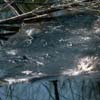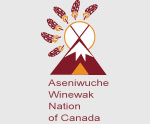Moose

The moose is the largest and arguably least attractive member of the deer family. Its shortcomings in appearance, however, disguise a physiology that is highly adapted to life in the north. Its big snout and short neck allow the moose to feed on the twigs and branches of trees, with those of deciduous trees making up the bulk of its diet. Its long legs allow the moose to manoeuvre efficiently through dense woodlands, wetlands, and deep snow, making it a challenge for hunters, both human and animal, to catch. Males have large, broad antlers, which female moose lack. A wide ranging animal, moose can be found in wooded regions that have a lot of young tree growth, as the moose prefers tender budding trees for food.
Traditional Uses:
For the Aboriginal Peoples of the boreal forest, especially those who lived in the central to south woodlands, the moose was a main source of meat, hides, medicines, and material for making a number of tools.
Many parts of the moose were considered edible by Aboriginal Peoples. Aside from meat that came from the main part of the body, many parts of a moose’s head, including the jaws and the ears, could be eaten. Rumen, or partially digested plant matter, from a moose’s intestines were squeezed out and cooked. The cape around a moose’s stomach was fried and eaten as a treat called crackling.

Moosehide was used in all aspects of traditional life. Mitts, moccasins, mukluks, packsacks, rifle carrying cases, and covers for drums could be made from moosehide. A moose’s bladder could be cleaned, shaped, and used as a bag to store bear and moose fat, both of which could be used as cooking lard.
Medicine came from the moose as well. Nodules taken from the uterus of a female moose could be pressed to the eyes to relieve the pain of snow blindness. Moose rumen was packed into open wounds to help stop bleeding.





